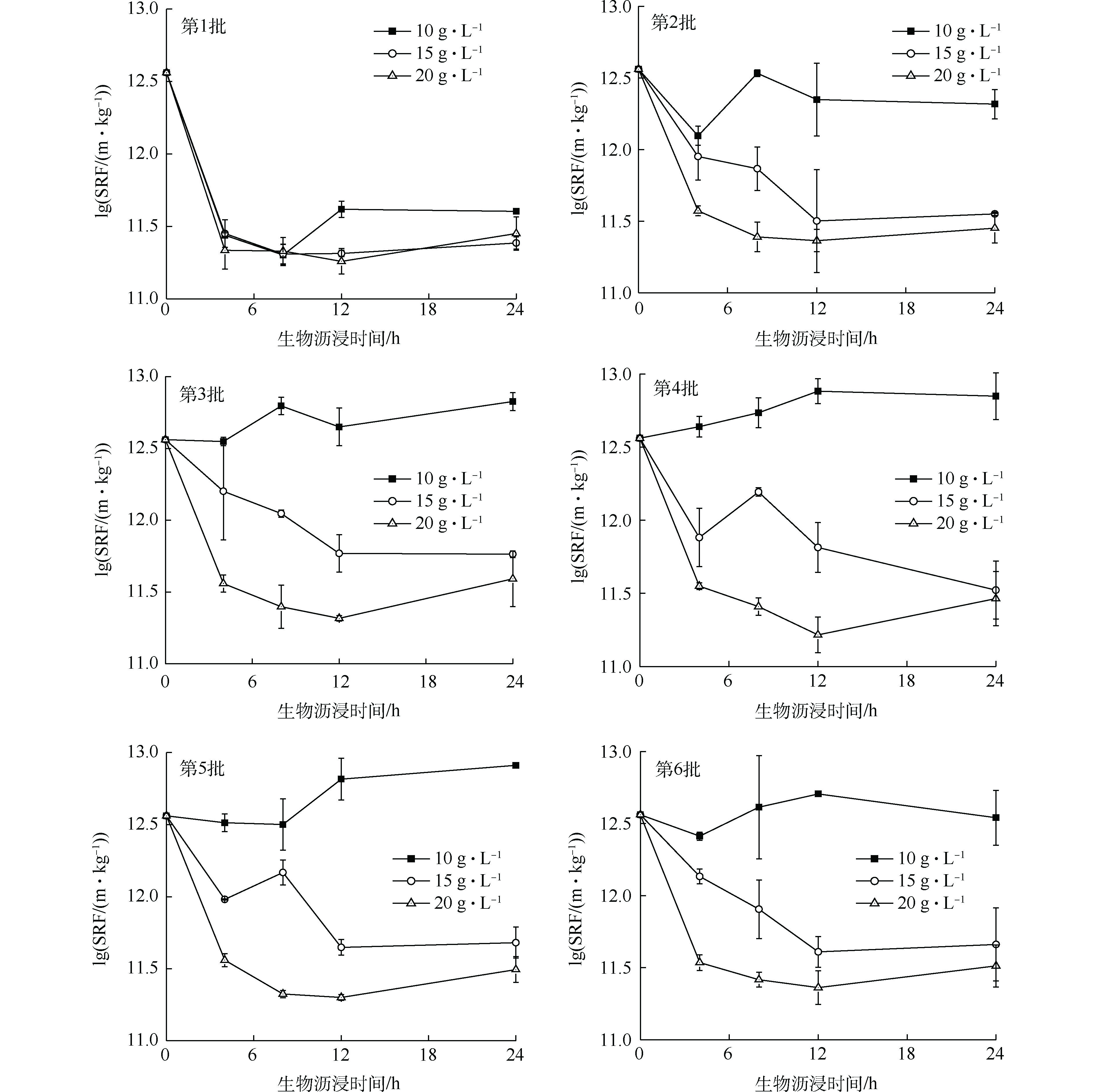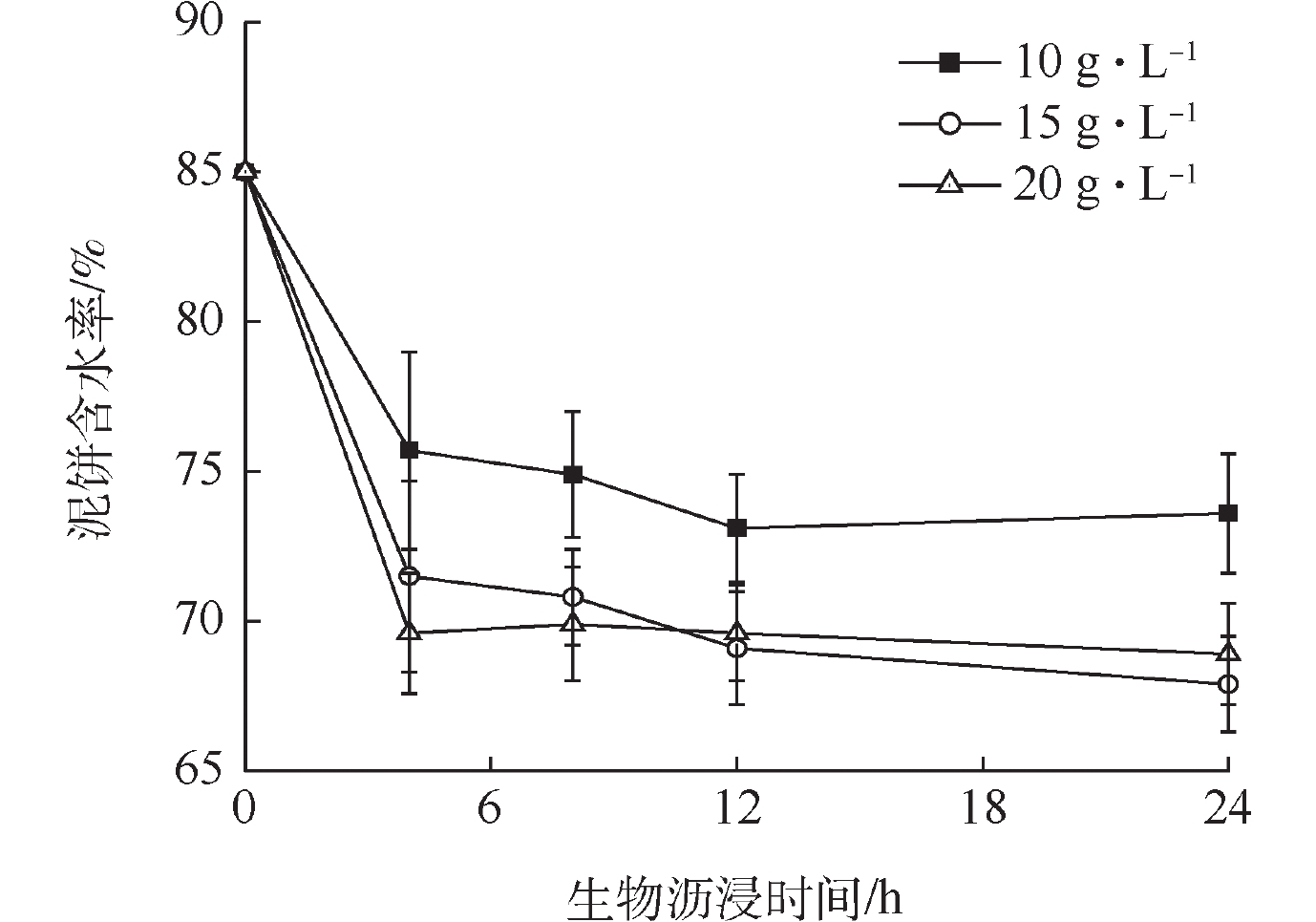-
为满足对畜禽养殖产品日益增长的需求,我国畜禽养殖业得到快速发展,因此,产生了大量畜禽粪污[1]。畜禽粪污经沼气工程后会将其生物质能转化为沼气,具有良好的经济效益[2-3]。但与此同时也会产生大量沼液。沼液中含有大量的病原菌、重金属,环境风险高,若随意排放或处理不当会污染生态环境,甚至危及人类健康[4-5]。
目前,规模化猪场粪污废水和沼液通常采用常规生化法处理,但一般效果较差,其中SS是最大的限制因素[6-7]。因此,沼液在进入生化处理前需要尽可能地去除SS。生物沥浸法是一种利用微生物调理,采用深度除渣机进行固液分离的技术。近年来,该技术主要用于环境污染领域的治理,如市政污泥的深度脱水[8-9],重金属污染土壤与河道底泥的生物修复[10-11],畜禽粪污中重金属的去除[12-13]等。该技术不仅可以有效回收污泥/粪污中的SS,脱除重金属,消除恶臭,绿色环保,而且经固液分离获得的泥饼(含水率低于60%)可用于资源化处理[14]。
对于猪场沼液采用生物沥浸法是否可行,相关研究报道较少。为此,本研究考察了不同浓度的营养剂对生物沥浸处理猪场沼液的影响,并重点考察了pH、比阻、泥饼重金属含量以及滤水水质等指标,以期为猪场沼液的处理提供借鉴和参考。
全文HTML
-
猪场沼液:取自江苏南京浦口区某典型猪场,该猪场采用干清粪的清污方式,粪污和污水全部进入CSTR厌氧发酵罐内,厌氧发酵60 d。取回猪场沼液立即测定其基本理化性质,结果见表1,并将其放置于4 ℃冰箱内保存,使用前用去离子水稀释至含固率为3%。
-
微生物的制备:参考相关文献[11,15-16],将从市政污泥中分离的嗜酸性化能自养菌A. ferrooxidans LX5, A.thiooxidans TS6和嗜酸性异养菌Galactomyces sp. Z3,Rhodotorula sp. R30,Pichia sp. D13纯菌株,分别接种到100 mL相应的无机盐或PDA液体培养基中,各培养基预先用硫酸酸化至pH为4,在28 ℃往复摇床中,以180 r·min−1的转速振荡培养;待各培养基中微生物密度约108个·mL−1时,再分别从5个培养基中各吸取1 mL,加到100 mL相应的液体培养基,从而获得加富的菌种,按1∶1∶1∶1∶1的体积比,将5种菌种混合,获得生物沥浸复合微生物。接种物的制备:取1.2 L稀释沼液,缓缓加入0.4 L生物沥浸复合微生物,按总体积的1.98%添加微生物营养剂[17](主要含Fe,S,N,P,K等),待pH降至3以下,将该沥浸泥作为生物沥浸接种物。
-
在一系列500 mL三角瓶中加入150 mL稀释样品,然后缓缓加入150 mL上述接种物,添入浓度为10、15和20 g·L−1(以总体积计)的微生物营养剂作为能源物质,共为3种处理,每种处理设3个平行。将三角瓶放置于28 ℃,180 r·min−1的往复式摇床中振荡培养,每12 h利用称重法补足蒸发水,周期为24 h。分别于0、4、8、12 和24 h取样,测定pH、比阻和泥饼含水率,待生物沥浸结束,测定抽滤水的COD、NH3和TP,并将该酸化污泥回流作为下批实验的接种物,回流比为1∶1,共6批。待第6批结束时,测定泥饼中重金属Cu、Zn的含量。
-
利用pHS-3C精密pH计测定pH;采用快速消解分光光度法测定COD;采用纳氏试剂比色法测定氨氮含量;采用钼锑抗分光光度法测定总磷含量;泥饼采用王水-高氯酸-氢氟酸法[18]消解,消煮后上清液采用等离子发射光谱法(ICP-OES)测定其重金属含量;采用布氏漏斗-真空抽滤法[19]测定比阻;采用105 ℃烘干法测定泥饼含水率。
1.1. 实验原料
1.2. 生物沥浸所需微生物和接种物的制备
1.3. 猪场沼液的生物沥浸实验
1.4. 分析方法
-
生物沥浸过程中,微生物可将营养剂中的能源物质(Fe,S等)氧化并获得能量,同时直接或者间接通过Fe3+水解释放H+,进而降低体系pH,并使得重金属从固相迁移至液相。通常将pH作为评价生物沥浸效果的重要指标,pH下降越快,表明微生物活性越强,处理效果越好。一般该微生物的最适pH在2.0~3.5[20-22]。
从图1可以看出,随着营养剂浓度的增加,体系的pH也随之降低。浓度为10 g·L−1的处理,沼液经第1批生物沥浸处理4 h内,pH从8.0快速降至5.0左右。其主要原因是,初期接种物的酸性强,与沼液反应时消耗大量碱性物质。4~24 h后,pH缓慢降低,仅降低1个单位。第2~6批,生物沥浸处理4 h内pH从8.0降至5.5,4 h后,pH基本保持不变。随着回流批次的延长,体系的pH一直较高。侯庆杰等[17]利用生物沥浸法回流处理洗毛废水时也发现类似的现象。这首先是由于环境中较高的pH使得复合菌群的活性降低,产酸作用受到影响;其次,在pH较高的条件下,营养剂中的Fe2+有一部分自然氧化,微生物生长受抑制,生物沥浸效果差。
浓度为15 g·L−1的处理,连续6批生物沥浸处理4 h内,pH均从8.0降至5.0左右,之后快速降低,每批反应结束时,pH均可维持在3.2左右,满足微生物生长的环境。与15 g·L−1的处理相比,浓度为20 g·L−1处理时的pH更低,pH下降速度更快,生物沥浸4 h内,pH从8.0降至4.5左右,24 h时,pH可以降至2.5左右。
-
过滤比阻作为评价污泥或粪污脱水速率的指标,能较好地反映其固液分离性能[23]。一般认为,过滤比阻SRF>4.0×1012 m·kg−1时,脱水速率较差;SRF在1.0×1012~4.0×1012 m·kg−1时,脱水速率中等;SRF<1.0×1012 m·kg−1时,脱水速率较好[24]。
图2反映了营养剂浓度对生物沥浸处理猪场沼液过程中比阻的影响。原稀释沼液的比阻为3.6×1012 m·kg−1,脱水速率中等。营养剂浓度为10 g·L−1的处理,沼液经第1批处理后,比阻降至3.0×1011 m·kg−1;第2~6批生物沥浸过程中,比阻均保持在1012 m·kg−1以上,甚至高于处理前。随着反应时间的延长,比阻逐渐增加的原因可能是,在能源物质不足的条件下,沼液中的异养菌重新成为优势菌,释放大量亲水性强的EPS[9]。
浓度为15 g·L−1的处理,第1批生物沥浸4 h内比阻可从1012 m·kg−1降至3.0×1011 m·kg−1左右,4 h之后基本保持稳定;第2~6批,随着生物沥浸时间的延长,过滤比阻逐渐降低,12 h的过滤比阻可降至5.0×1011 m·kg−1左右,脱水速率较原稀释沼液提高86.1%。脱水速率提高的原因可能是,生物沥浸过程中会产生大量H+,使得Zeta电位趋于中性,颗粒之间排斥力减小,同时生物形成的矿物及Fe3+起较好的絮凝效果[25-26]。
浓度为20 g·L−1的处理,第1~6批经处理4 h过滤比阻即可降至3.0×1011 m·kg−1左右,4 h之后比阻缓缓降低后微微升高,但与浓度为15 g·L−1的处理结果相比,其比阻值更低。
-
泥饼含水率作为评价脱水性能的指标,能较好地反映脱水程度。泥饼含水率越低,脱水程度越高,体积也越小[27]。营养剂浓度对生物沥浸处理猪场沼液过程中泥饼含水率的影响(取第1~6批数值作统计分析)见图3。
原稀释沼液的泥饼含水率高达85%,外观呈黑色黏稠状,含有大量表观水,脱水程度较差。浓度为10 g·L−1的处理,处理4~24 h的泥饼含水率为75%左右,体积减少40%。浓度为15 g·L−1和20 g·L−1的处理,泥饼含水率逐渐降低,泥饼含水率变化较小,4~24 h稳定维持在70%左右,脱水程度大大提高,体积减少50%。结果发现,与原空白相比,沼液经生物沥浸处理后,脱水程度均得到提高,体积减小,但营养剂浓度对其影响也小。
-
由表2看出,经不同生物沥浸处理后滤水的COD基本维持在423.8~499.3 mg·L−1,氨氮在671.4~704.0 mg·L−1,总磷在0.7~1.1 mg·L−1,SS为0 mg·L−1,与原稀释沼液相比,其最高去除率分别为98.5%、33.8%、99.9%和100%,获得的滤水较清。
猪场沼液经生物沥浸处理后污染物浓度大大降低,但不同处理后的水质无显著差异。生物沥浸法对氨氮的去除作用明显弱于COD和总磷,可能的原因是,沼液中氨氮是以溶解态形式存在的,生物沥浸微生物对氨氮的吸附作用有限。因此,经固液分离后,抽滤水的氨氮浓度依然较高,但有机物和总磷以颗粒态形式存在,经过微生物絮凝、固液分离,伴随SS一起被去除[7]。
-
生物沥浸期间pH降低,沼液固相中的重金属会溶出。其浸出率主要取决于pH,理论上pH越低,重金属浸出率越高。浓度为10 g·L−1处理组的浸出率要远低于15 g·L−1和20 g·L−1的处理组;在浓度为10 g·L−1的处理组中,Cu的浸出率几乎为0%,Zn的浸出率仅为5.8%;在浓度为15 g·L−1的处理组中,Cu、Zn的浸出率较高,分别为49.5%、72.7%;在浓度为20 g·L−1的处理组中,浸出率分别为71.0%、82.7%(见表3)。研究发现,Zn的浸出率总是高于Cu,这可能是因为重金属Cu主要以稳定态和硫化物存在,CuS的溶度积Ksp远低于ZnS,pH低于3时才会大量溶出[28-29]。
2.1. 营养剂浓度对生物沥浸处理猪场沼液过程中pH的影响
2.2. 营养剂浓度对生物沥浸处理猪场沼液过程中比阻的影响
2.3. 营养剂浓度对生物沥浸处理猪场沼液过程中泥饼含水率的影响
2.4. 营养剂浓度对生物沥浸处理沼液后抽滤水中COD、氨氮、总磷的影响
2.5. 营养剂浓度对生物沥浸处理后泥饼重金属的影响
-
1)营养剂浓度对猪场沼液经生物沥浸后的脱水性能和重金属浸出影响较大。在3种不同的处理中,营养剂浓度越高,处理效果越好。当营养剂浓度≥15 g·L−1时,沼液经生物沥浸处理后,脱水性能提高86.1%以上,泥饼重金属Cu、Zn的浸出率分别在49.5%、72.7%以上,且连续多批次回流处理24 h后的pH可降至3.5以下。
2)营养剂浓度对猪场沼液经生物沥浸后的泥饼含水率和滤水水质影响较小。但通过生物沥浸法均能够回收沼液中几乎100%的SS,从而降低滤水后续生化处理的难度。因此,利用生物沥浸处理猪场沼液具有良好的应用前景。




 下载:
下载:



